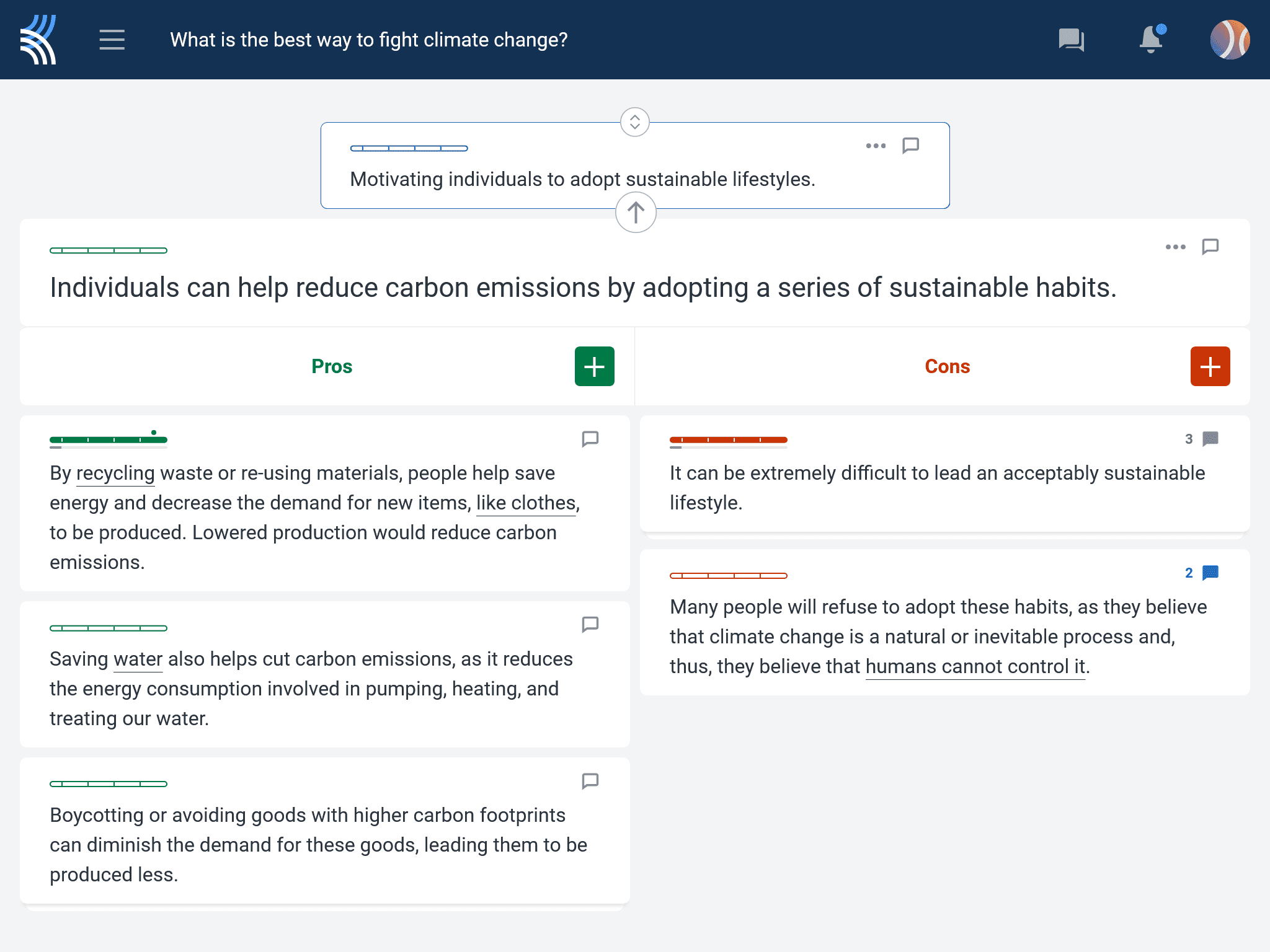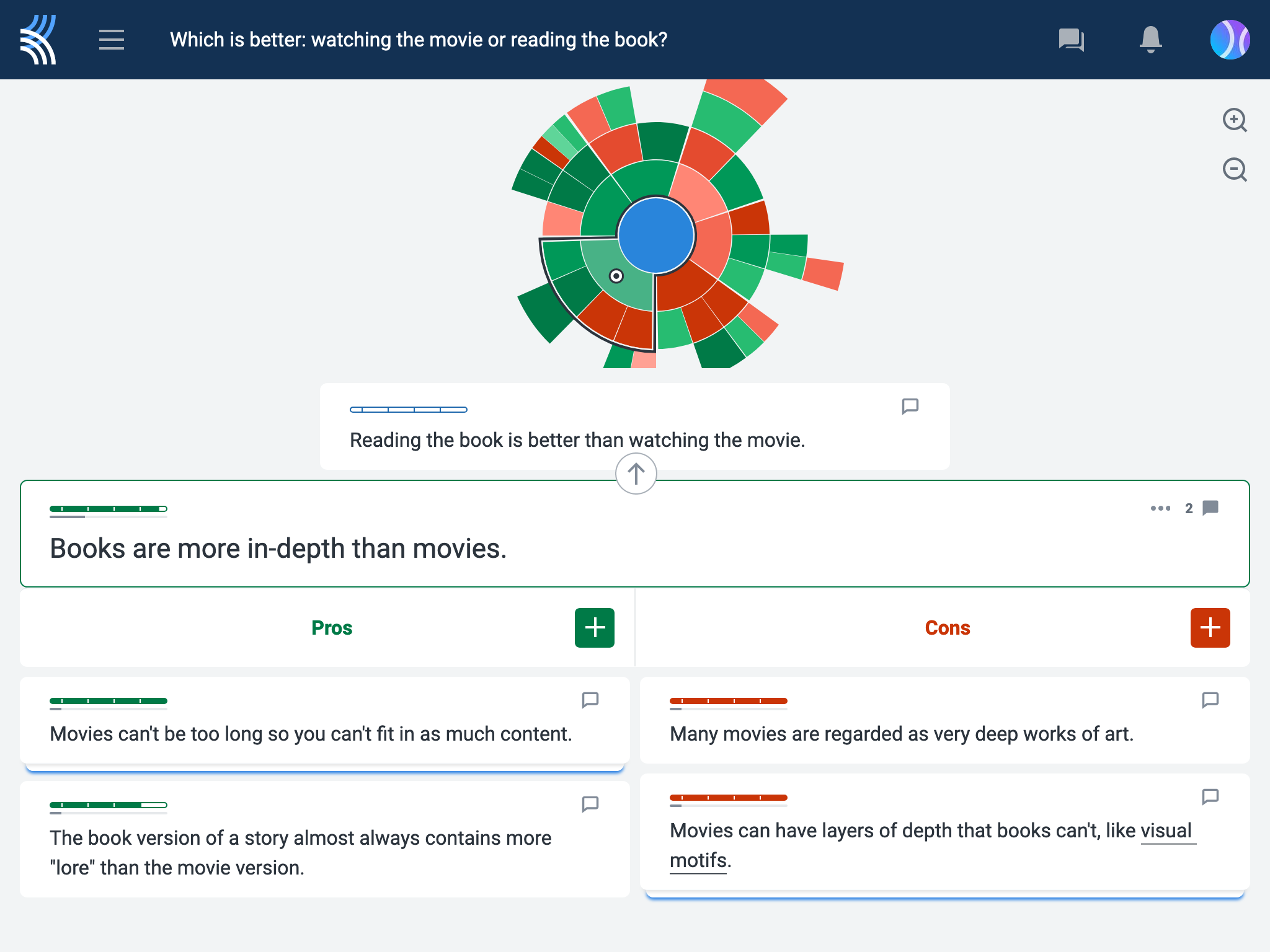Strong argumentation skills can boost students’ academic performance and help them master a range of 21st-century skills. In this article, we will explore the importance of argument structure, examine the steps students should take to structure an argument, and discover how you can use Kialo discussions (for free!) to support students in building these skills!
Why should students learn strong argumentation skills?
First, developing strong argumentation skills is integral to training students’ problem-solving abilities. As students craft thesis statements and supporting claims, they gather information and perspectives that help determine their position and decide how they will persuade the audience to accept their viewpoint.
Second, practicing argumentation trains students’ critical thinking skills, as they learn to use evidence-based reasoning to support their arguments. Students must analyze and evaluate evidence to bolster their claims and invalidate opposing viewpoints, proving that their thesis is the logical choice.

Finally, mastering argumentation through writing argumentative essays, giving oral presentations, and having classroom debates empowers students to advocate for their own views, negotiate effectively, and make well-reasoned decisions. These are invaluable skills that will benefit students throughout their academic, personal, and professional lives.
What are the features of a well-structured argument?
Crafting a well-structured argument gives students credibility, helping them persuade audiences of the validity of their viewpoint. Here are the main features students should include in their arguments:
- Logical organization of main points
Students should organize their main points in a logical order that guides the audience through their reasoning.
- Grouping of claims and evidence
Students should group their claims and related evidence together into distinct sections, with each section focusing on a different aspect of the topic.
- Clear and precise language
Students should use clear and precise language throughout their argument. Avoiding ambiguity ensures the audience can understand students’ reasoning.
- Inclusion of signal words
Students should include discourse markers to signal the difference between supporting arguments and any counterarguments they address.
How to teach students to structure an argument: step-by-step
Providing students with a simple structure for their arguments reduces their cognitive load, allowing them to focus on the content of the argument itself. Some common techniques include the PEEL, TTEB, Toulmin, Classical, and Rogerian Methods.
No matter which structure you’re most familiar with, here’s a step-by-step guide on how you can help your students successfully structure arguments.
Step 1: Have students prepare to make a good argument
Have students begin with identifying the topic and audience in order to craft a compelling argument. To fuel engagement, ensure students are invested in the topic. Thus, allow them to choose a topic they’re interested in, such as social media or sports, or help them to find meaningful aspects in assigned topics.
Students must also consider their target audience, as the audience’s background and prior knowledge may influence the evidence, tone, and claims or counterclaims that students select.
With this in place, students should develop a broad topic knowledge through conducting in-depth research into different perspectives on the chosen or assigned topic. Here, students can outline the diverse viewpoints they encounter on a pro/con chart, such as a Kialo discussion, enabling them to select the position they will argue for.

Step 2: Students introduce the argument with a good thesis
In the introduction, students must include two things:
- An engaging hook to explain the topic’s relevance or importance to the audience.
- A concise, well-structured thesis statement of one to two sentences that asserts their position.
The thesis must be debatable, with enough evidence available to support the student’s perspective, but no obvious conclusion.
Step 3: Write claims and use evidence to support the thesis
After the thesis, students should argue in favor of their central claim, using supporting points backed by relevant, substantive evidence.
Here, students can combine factual data, logical reasoning, relevant statistics, or convincing anecdotal evidence to provide thorough justification for their position and convince the audience to accept their viewpoint.
Step 4: Use counterarguments to strengthen arguments
Addressing counterarguments increases the author’s credibility, and therefore strengthens the perspective presented. The audience sees that the author has done their due diligence in considering different viewpoints before taking a position.
Thus, students should respectfully acknowledge and then rebut counterarguments in an unbiased manner. There are two ways to do this:
1. Refutation
For neutral or supporting audiences, students can refute a counterargument by identifying unsound reasoning, such as logical fallacies, unstated assumptions, and unreliable data. They can also refute a counterargument by providing counterexamples or counterevidence.
2. Concession
For more skeptical audiences, students can use concession to acknowledge the merits of opposing arguments. Then, they can use substantial supporting evidence to demonstrate that their own claims are stronger.
Step 5: Conclude an argument with a call to action
In closing, students revisit the thesis in light of their argument, synthesizing the main information without repeating specific details. They should summarize the topic’s importance and key arguments, before including a call to action for the audience, aligned with the argument’s purpose.
How can students use Kialo discussions to structure arguments?
The Kialo Edu Topic Library is bursting with a range of discussion topics that serve as excellent prompts for students to practice their argumentation skills — and provide an ideal framework to help students structure their ideas.
1. Students can use the argument-mapping structure of the Kialo discussion to visualize a clear structure for arguments

Kialo Edu discussions are built on argument-mapping principles. Each discussion starts with a central thesis. Then, students add pros and cons which are joined by connective lines showing how each point logically connects to another. This builds an interactive visual representation of the entire discussion, which students can use to improve the structure of their arguments.
2. The argument-mapping structure encourages students to investigate multiple perspectives
The argument-mapping structure of a Kialo discussion arranges green “pros” on the left and red “cons” on the right of each claim, so students can immediately see whether a claim is meant to support or oppose the point above. This clear separation between pros and cons encourages students to consider opposing perspectives, so they can identify and address counterarguments, rather than dismissing them.
3. Students can easily add evidence to support their claims
As students structure their arguments, they can seamlessly link to supporting sources in their claims, adding notes or quotes that explain exactly how their source supports their reasoning. These sources are then compiled into a handy sidebar that helps students to match the evidence with the relevant claim within paragraphs — and meet citation requirements for their argumentation assignments.

4. Students can receive and implement feedback from teachers to improve their arguments
Seeing students’ arguments displayed visually means teachers can easily spot and address logic and structural errors in their students’ work at the planning stage. Using the Grading and Feedback feature, educators can then guide students’ arguments by scoring individual claims or providing personalized feedback. Students can view their feedback in the Grading sidebar and use it to refine the structure and reasoning of their arguments.

Teaching students how to structure an argument equips them for success across various academic disciplines. Moreover, it’s a highly transferable skill — the ability to present ideas clearly and persuade others enables students to engage in constructive, democratic discourse.
Explore how you can use Kialo discussions to activate your students’ argumentation abilities and empower them with this lifelong skill!

